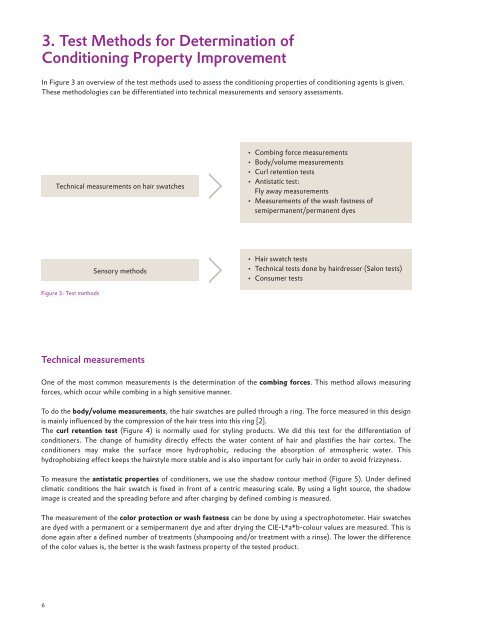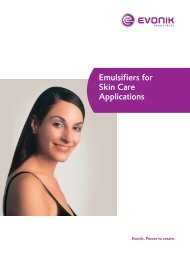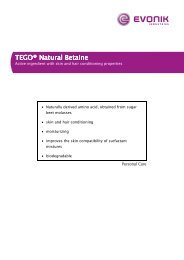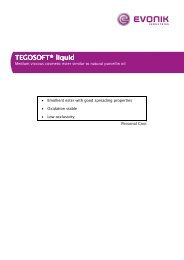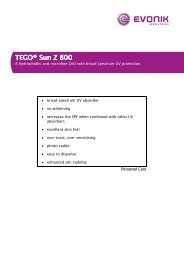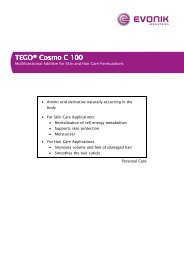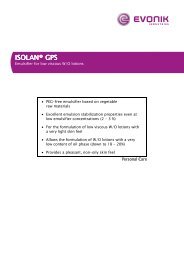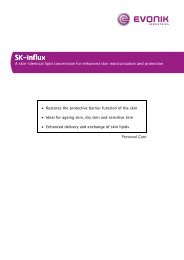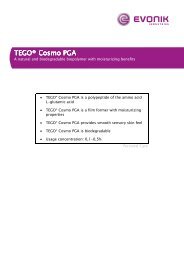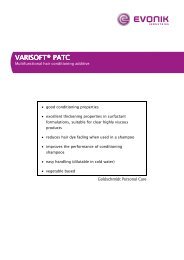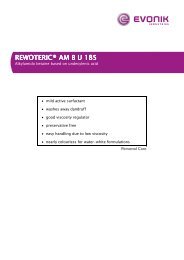Hair Types and Required Specific Ingredients for Conditioning ...
Hair Types and Required Specific Ingredients for Conditioning ...
Hair Types and Required Specific Ingredients for Conditioning ...
You also want an ePaper? Increase the reach of your titles
YUMPU automatically turns print PDFs into web optimized ePapers that Google loves.
3. Test Methods <strong>for</strong> Determination of<br />
<strong>Conditioning</strong> Property Improvement<br />
In Figure 3 an overview of the test methods used to assess the conditioning properties of conditioning agents is given.<br />
These methodologies can be differentiated into technical measurements <strong>and</strong> sensory assessments.<br />
Technical measurements on hair swatches<br />
• Combing <strong>for</strong>ce measurements<br />
• Body/volume measurements<br />
• Curl retention tests<br />
• Antistatic test:<br />
Fly away measurements<br />
• Measurements of the wash fastness of<br />
semipermanent/permanent dyes<br />
Sensory methods<br />
• <strong>Hair</strong> swatch tests<br />
• Technical tests done by hairdresser (Salon tests)<br />
• Consumer tests<br />
Figure 3: Test methods<br />
Technical measurements<br />
One of the most common measurements is the determination of the combing <strong>for</strong>ces. This method allows measuring<br />
<strong>for</strong>ces, which occur while combing in a high sensitive manner.<br />
To do the body/volume measurements, the hair swatches are pulled through a ring. The <strong>for</strong>ce measured in this design<br />
is mainly influenced by the compression of the hair tress into this ring [2].<br />
The curl retention test (Figure 4) is normally used <strong>for</strong> styling products. We did this test <strong>for</strong> the differentiation of<br />
conditioners. The change of humidity directly effects the water content of hair <strong>and</strong> plastifies the hair cortex. The<br />
conditioners may make the surface more hydrophobic, reducing the absorption of atmospheric water. This<br />
hydrophobizing effect keeps the hairstyle more stable <strong>and</strong> is also important <strong>for</strong> curly hair in order to avoid frizzyness.<br />
To measure the antistatic properties of conditioners, we use the shadow contour method (Figure 5). Under defined<br />
climatic conditions the hair swatch is fixed in front of a centric measuring scale. By using a light source, the shadow<br />
image is created <strong>and</strong> the spreading be<strong>for</strong>e <strong>and</strong> after charging by defined combing is measured.<br />
The measurement of the color protection or wash fastness can be done by using a spectrophotometer. <strong>Hair</strong> swatches<br />
are dyed with a permanent or a semipermanent dye <strong>and</strong> after drying the CIE-L*a*b-colour values are measured. This is<br />
done again after a defined number of treatments (shampooing <strong>and</strong>/or treatment with a rinse). The lower the difference<br />
of the color values is, the better is the wash fastness property of the tested product.<br />
6


